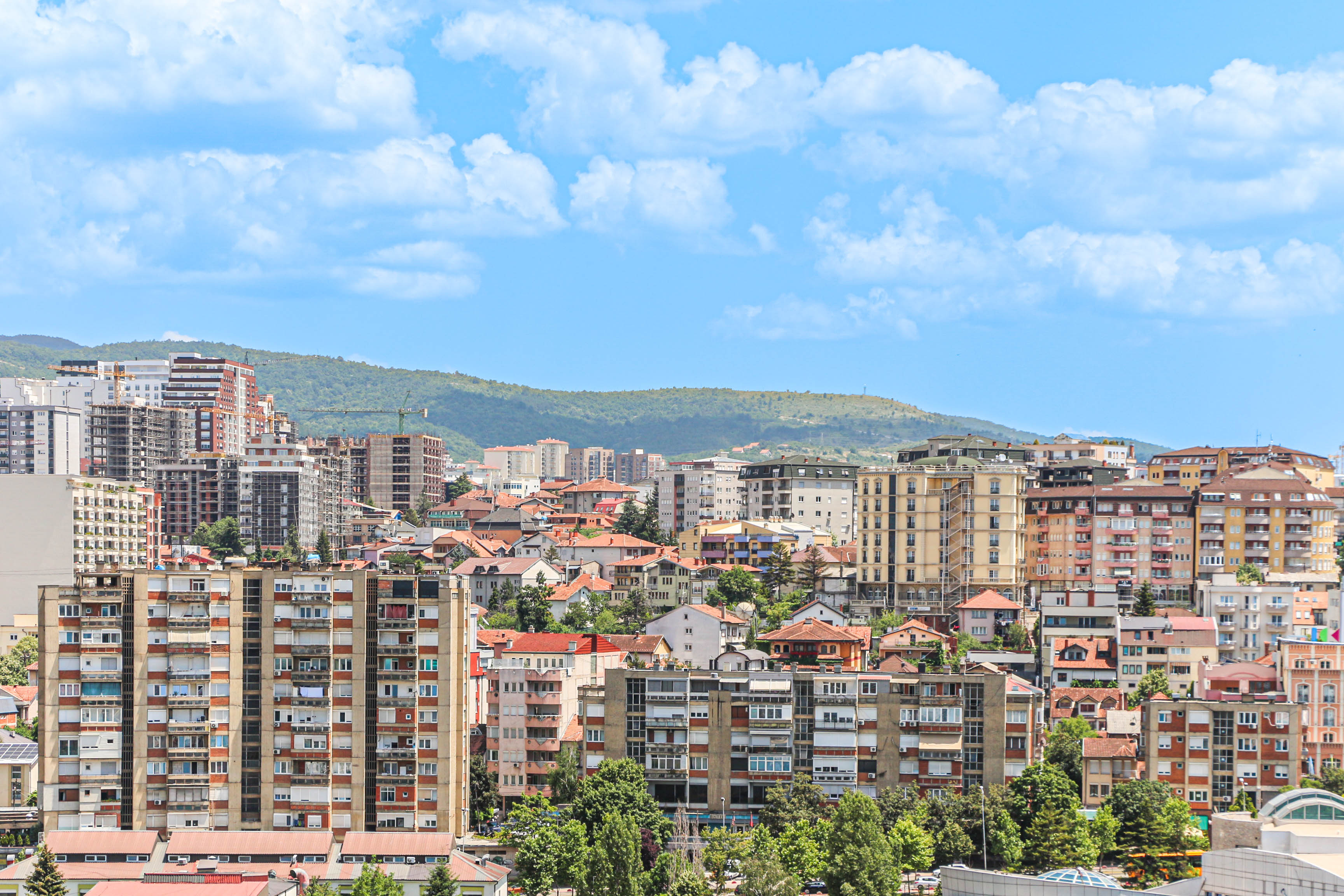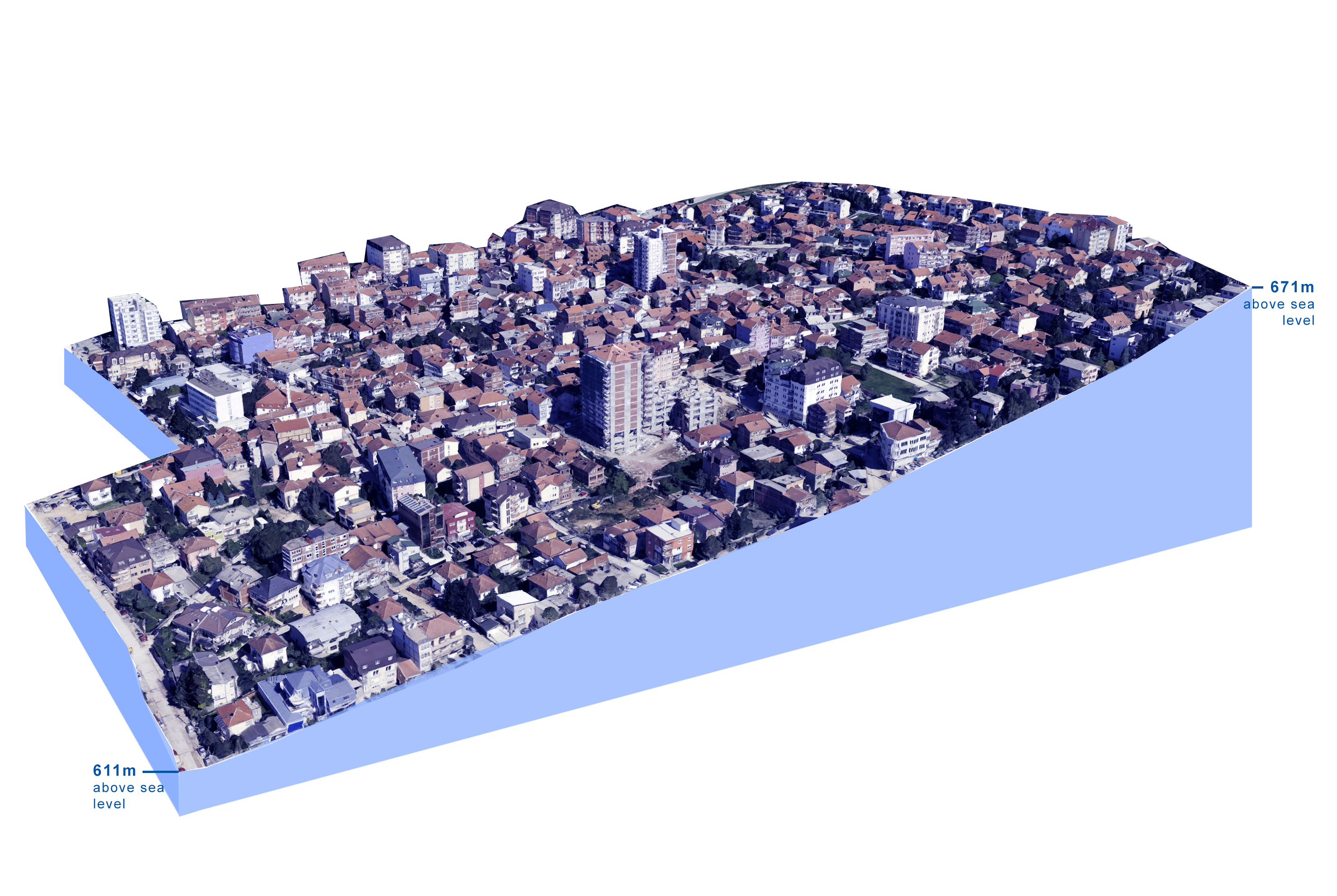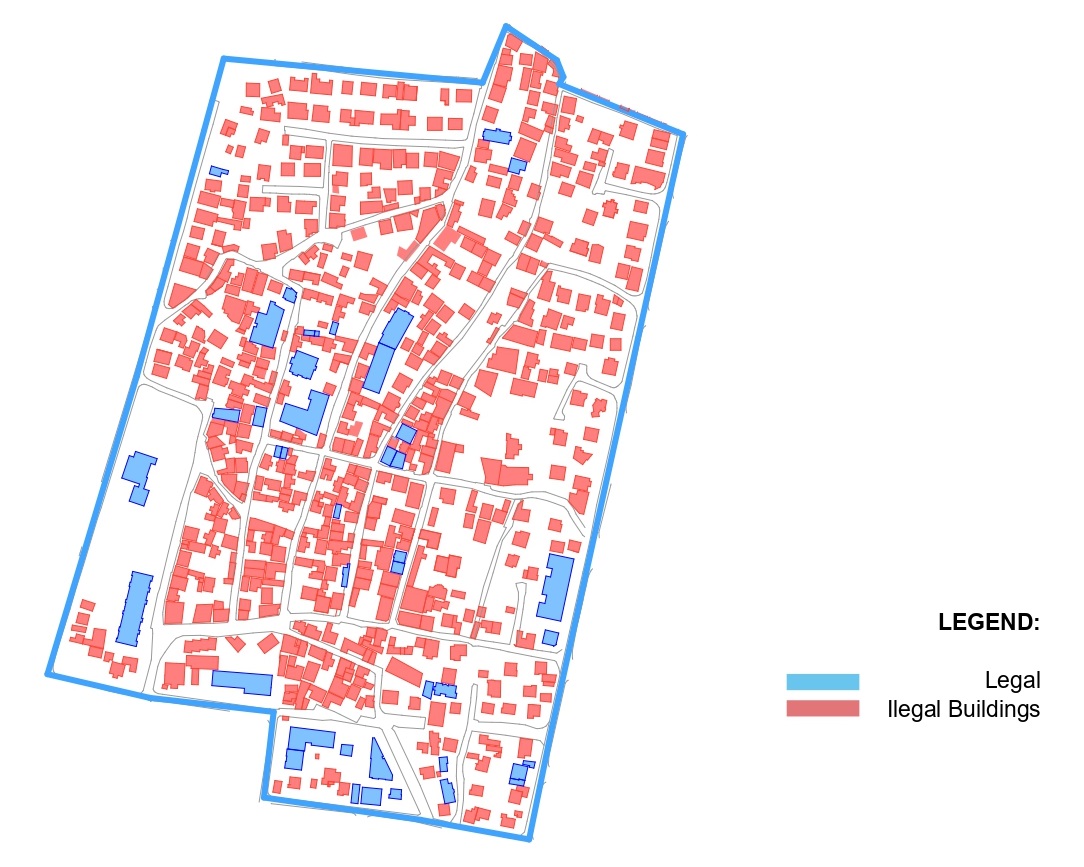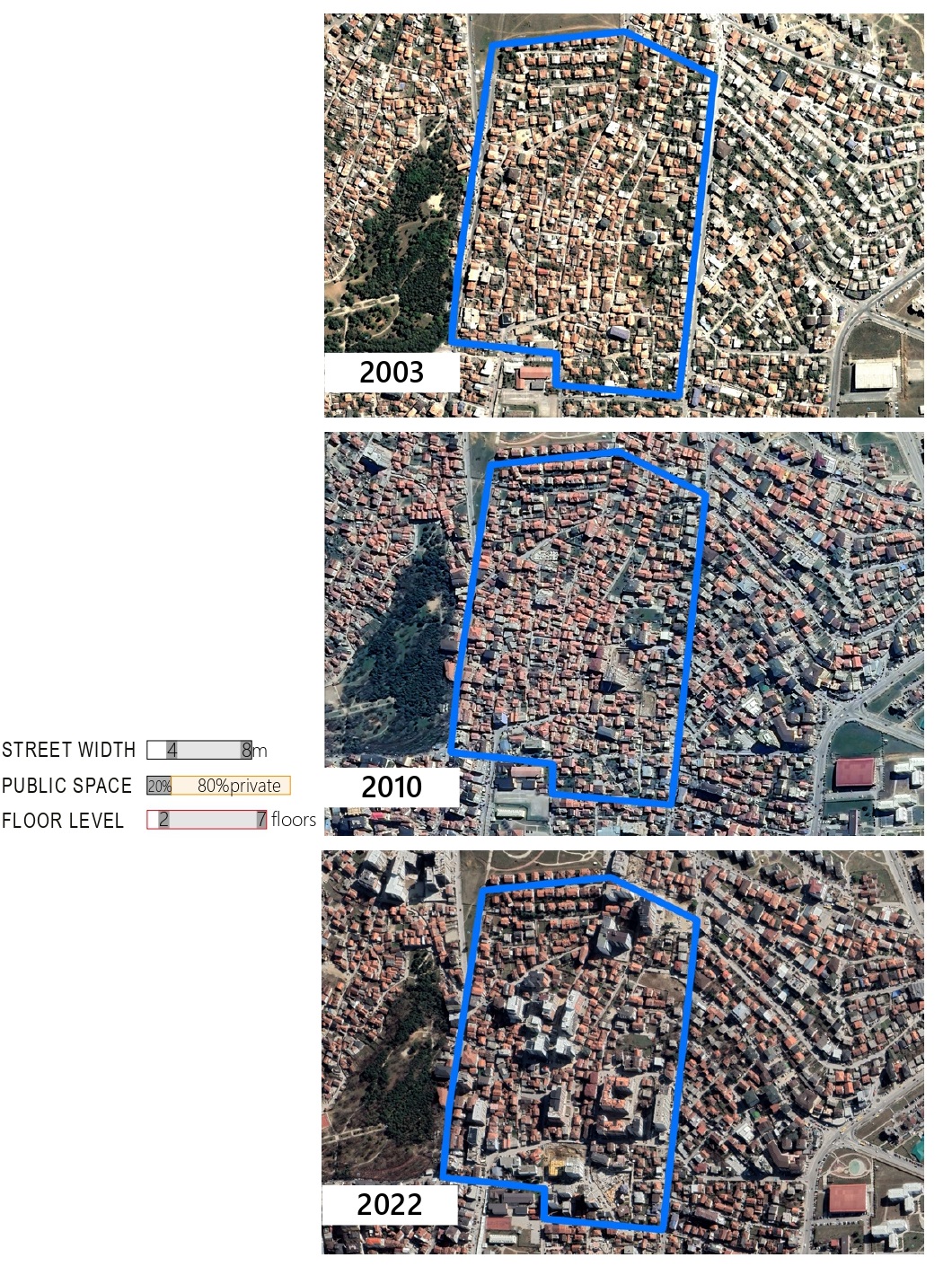
Introduction
Pristina was liberated during 1999, and at this time many problems found in every sphere of life.
Lack of professional administrators, lack of architects and urban planners, lack of regulation plans,
etc. were some main points that were connected direct to architectural and urban development. The
challenges just began for this city of Pristina, in terms of urban and architectural development. Some
parts of the city were demolished from regime during the war, and after the war, the inhabitants started
to come back to their houses. The first goal at this time was to rebuild their houses. This was an
emergency phase of the housing need. The transformation of the city just began with new individual
houses in 2000 without regulation plans for mostly of neighborhoods.
The neighborhoods of Muhaxhere before the war were mostly with individual houses built, and the
density was not too high. The socialist period was notable for being the most successful in urban
planning. This period had helped create an urban and architectural identity through administrative,
cultural, hotel, sports facilities, etc.; that had created a genius loci for the citizens. The construction
of individual houses in the Muhaxher neighborhood does not present an architectural identity, due to
the high number of informal buildings.
As support in every field the international actors landed in Pristina during 2000, their goal was to
help create legal institutions and professionalize the administration. During their mission in Kosovo
were drafted buildings laws at 2004 that were necessary for the country and they organized some
workshops related to the topic how to do spatial plans in Kosovo.
Migration was a factor that had influence of city development. Pristina seen to be a potential city with
many opportunities to find a job, education, culture and social life etc.; For those reasons Migration
from other part of Kosovo to Pristina started to change with Housing situation. The buildings companies
seen that the requirements for livings space are increasing, they began immediately to build
new buildings complex with more than 4 floors.
Understanding better the city development of capital city Kosovo we should mentioned 3 periods of
development that are different with each other:
- Ottoman empire;
- Socialism;
- After the war 1999-;
The city was influenced quit well from ottoman empire, and the characteristics of this period were
2-story houses with decoration and made of stone, wood and clay, while the urban structure was organic,
which this structure still exists today. At the socialism period the neighborhoods in Pristina, especially
the neighborhoods of Muxhaxher did not change the way of improving this urban structure,
because, the mostly of properties are private, and did not exist any incitive to reorganize the plots.
But everything began to change after the war, constructions from the Socialism and Ottoman periods
vanished with new buildings, losing the meaning of the space that surrounds them. Because the new
constructions were built quickly and not qualitatively, they are otherwise called “Turbo Urbanism”.
The construction field became more profitable after the war, and the investment grew up every year.
Slope terrain and Informal Urban Growth
The 40-50% of territory of Pristina has a hill terrain, and our case study neighborhood of Muhaxher
has a slope terrain in (Fig. 1), and is located near the city center. In the past, streets on the neighborhood’s
Muhaxher were organized spontaneously, following the trajectories of the plot divisions, and
the streets were shaped by citizens’ needs. During the ’80s, there were few cars, so the streets in
this neighborhood were narrow, 3-5 m wide. After the end of the war, the condition of the streets in
this neighborhood has not changed, although the numbers of residents and cars increased last time.
The steepness as an influencing factor, has made some streets passable only for pedestrians with
informal infrastructure and to narrow. The lack of parking spaces has made movement more difficult
for pedestrians, cyclists, and cars in this neighborhood. The residents park their cars front of their
house that occupied the pedestrian way and the street as well. That seems to be normal from inhabitants
because they do not have other opportunity for parking. Blocking roads in this way is affecting
people’s psychology because they have to be careful walking on these roads and cannot ride bicycles.
The poor infrastructure in this area is directly affecting the quality of life of citizens.
The disadvantage of Municipality of Pristina is that they do not require for new build to build their
house parking. Considering these problems such as: roads blocked by cars, narrow streets, lack of
parking a lot in steep terrain; it affects the safety of the neighborhood, such as interventions in case
of fire. Many houses are close to each other and the roads are not suitable for penetration by fire
trucks. Archis Intervention5 has created several manuals to improve the existing urban and Archi
tectural situation in the city of Pristina, but which unfortunately have not been implemented by the
Municipality of Pristina. This manual includes not only aspects of security and infrastructure but also
addresses illegal constructions, 3 aspects that are considered most important by archis intervention
are:
- The security aspect;
- The social aspect;
- The technical and social infrastructure aspect;
Informality in architecture can be observed in the facades of buildings that are not aligned with each
other, presenting to the human eye the form of disorder and spatial chaos. Also, the distance of
buildings from each other is variable. It differs based on the type of plot and building. We can raise
the fact that in case of fire, neighboring buildings may also suffer because the buildings are not built
according to EU fire regulations. Also, the phenomenon of the heights of buildings differs from each
other. Regarding the safety of buildings against fire, the reason for the poor infrastructure is the lack
of water hydrants, which in emergency cases could be used for intervention.
These informal and illegal developments were a consequence of the country being in political, economic,
legislative transition, etc. Informal urban and architectural development occurred due to the
frequent transitions that Balkan cities experienced and the numerous influences of private and state
property. The lack of laws and professional persons made it very difficult to take the urban development
situation of the city into their own hands. This lack of rules such as planning was exploited by
builders, investors, architects, etc. The Municipality of Pristina did not have sufficient capacity to draft
the necessary plans for the city. They had contracted architecture offices to create regulatory plans,
even though these offices did not have the necessary experience in the field of planning, they had
drafted them with many problems and deficiencies in neighborhood analysis.

urban development, and new buildings have been built adapting to this context. But without trying
to improve the urban situation. The non-geometric morphology in the Muhaxher neighborhood has
directly influenced the creation of opportunities for residents to offer their plots to create opportunities
to plan residential blocks (collective housing), which would be an opportunity for the conditions
for residents to be improved. By this we mean the creation of parking spaces, common spaces for
residents, green spaces, etc. The current situation shows that the transformation of the Muhaxher
neighborhood (Fig. 5), shows new buildings, which from individual houses (low-rise construction) has
been transformed into high-rise residential buildings up to 8 floors. This transformation has been
manifested with economic and political impacts and urban development.
The urban regulatory plan drafted in 20148 presents 3 categories of constructions according to the
size of urban blocks, which are not equal for builders. The height of the building depends on the size
of the plot.
Area High Usable prozent of plot:
- Category 1 100-450m2 P+3 0.4;
- Category 2 450-1000m2 P+6 0.4;
- Category 3 over 1000m2 unlimited 0.4;
This categorization of buildings according to the regulatory plans for this neighborhood makes the
way of development of this neighborhood in the urban context unfair. We can imagine in a residential
area 3 types of plots by size, and the built objects have different heights. Even though the construction
coefficient is the same, we have a great difference in the use of the plot. This categorization can
only fit for the construction mafia, who have the power to have plot areas larger than 1000 m² and
build high-rise buildings, violating the neighboring right to have sufficient lighting. The current situation
of the Muhaxher neighborhood in (Fig. 3), shows such a difference between high-rise buildings
and individual houses.
The informal solution is not a single process but varies by topography, climate, culture, materials,
economy, and politics. Strategies for improving informal buildings can only be successful if all levels
of citizens, institutions, investors, professionals, etc., are involved. A radical strategy for improving
informal buildings in Prishtina, most of which today also represent illegal buildings. This would be a
new beginning for that neighborhood and for the citizens, which would be in the interest of everyone
to improve the current situation, since informal architecture cannot be improved by private individuals
alone by only arranging the spaces on their plots. This is a complex topic: spaces should be treated
as a common part. Although it would be a great challenge, since the duration of the implementation
would be long-term, it would, on the other hand, be a sustainable solution. This would include the
re-planning of urban areas, including state interests, public-private interests, etc. To transform the
city, we must first change the perception of the city, to understand it as a shared space that can be
expanded horizontally and vertically without any problem. We must understand transformation as a
shared part of the community that can also improve the quality of life. Some questions we can naturally
raise: What is important in the city? What is missing? Citizens also raise their concerns about
the concrete transformation that is taking place in the spaces where they live. Their impression is
that new buildings are being built without any thought and their design shows that these buildings do
not belong in this neighborhood, they are not attractive. The sense of the city will be lost even more
in the future if the transformation does not change for the better.
3. New illegal constructions are making it difficult to improve the current urban situation
After the war was a new challenge for urban planners, architects, and the municipality of Pristina. Lack of regulation plans gave the opportunity for builder to built, what ever they want. Nowadays, in the whole territory of Pristina are more than 44,000 illegal buildings. This concern explains that most of the new buildings are built illegally, just because they ignore the plans and laws. The Municipality of Pristina has also been criticized for lengthy procedures for issuing construction permits. Citizens were forced to start construction, even illegally, thinking they would receive construction permits later.
The municipality of Prishtina lacked building inspectors. The entire territory of Prishtina had to be controlled by 4 building inspectors. This made it impossible to prevent informal and illegal constructions. Not only that, but the lack of public spaces such as parks, high green spaces, medical centers, schools, and public transportation makes it difficult for citizens to have a good life. Considering that young families need green spaces for their children, they are forced to go elsewhere to spend time in green spaces. This is as a result of the lack of public land in the Muhaxher neighborhood. The Municipality of Prishtina has not tried to find a strategy to create private-public areas that would benefit its citizens. There is even a lack of schools and kindergartens in this neighborhood, as basic things to develop a normal life.
In the post-war period, we have many people who have been called architects even though they have not had proper education but also lacked proper experience, especially on sloping terrain. In most cases, the objects were designed as if they were a flat plateau, and the sloping terrain was ignored. Lack of knowledge in the wide context of urban made that new buildings were built in informality; in this way we understood the community as needing just for a shelter, not for the effect that their house had by themselves in urban context.
The poor sewage infrastructure, taking into account the steep terrain of this neighborhood, during rainfall, and the lack of drainage, rainwater flows through the streets, bringing water to the flat areas. Rainfall is very harmful in Pristina due to the large number of buildings that are connected to the sewerage system. Some of these buildings were connected illegally and informally. The steep terrain has made it impossible to have a proper design for the sewerage and drainage network. The damage caused by the poor sewage infrastructure is very big, and during rainy periods, citizens are even prevented from moving freely. Unfortunately, Pristina is the only capital city on the Balkan that does not have a river. During rainy periods, it could be an advantage for the city, helping to prevent the streets from flooding. In fact, the city had two rivers until the 1980, but they were covered by the Municipality of Pristina, as a result of which they were stinking and giving the city a bad appearance.10
Illegal buildings are another problem that, after the war in 1999, had occupation mostly of part of the city. Concerning the map that I did base on the GIS View Data show us the building on this neighborhood are illegally (Fig. 4). Illegal means that the building did not build concerning the regulation plans of Municipality of Pristina, and the citizens built informality with their knowledge and without plans. The citizens of Pristina are afraid because if there is any earthquake in the future, the hypothesis is that some of the houses will demolish, and the steep terrain can be more dangerous.
Unfortunately, Pristina was transformed with illegal and informal constructions into a chaos. The current situation really shows how a city can be changed through design. Yes, if the design is not qualitative it does not give value to the city. Through urban design, the life of the citizen and social life can also be improved or to become dangerous. A permanent risk that occurs in every neighborhood of Prishtina is the collapse of the soil during the construction of new buildings. Considering the steep terrain in some neighborhoods, construction companies do not provide the working terrain. The collapse of the soil is endangering the lives of citizens. In 2024, at a construction site, 2 cars crashed into a worksite. However, the law obliges companies to prepare the terrain so that there is no flooding of the terrain. This also shows the real situation that construction companies take into account the safety of citizens. In the event of an earthquake or other disaster, the lives of citizens may be at risk due to the slope and poor quality of new construction. Citizens are afraid of earthquakes due to the poor quality of construction and the large number of illegal constructions in the city.
Improving the situation with illegal construction began in 2010 by creating laws for legalization. Various guidelines to inform citizens by informing about the procedure and documents required for application. More than 15 years have now passed since the legalization of illegal construction began, and we have no concrete results in improving the situation with construction. 
4. Conclusion
We briefly analyzed some of the main points that describe the current situation in our case study. The current situation was influenced by several factors that reflect poor urban and architectural development. This development is closely related to the lives of citizens, such as the lack of public spaces, schools, parks, parking lots, etc. Also, the lack of good planning by the Municipality of Prishtina has caused citizens to build outside the plan. Not only that, the fault for today’s constructions also lies with the citizens who have built spontaneously, according to their needs, which has directly affected the urban context of the city, which reflects informal constructions. For 25 years in the Muhaxher neighborhood we have new residential constructions that, in addition to housing space, do not offer citizens parking lots.
The steep terrain and private plots have made the transformation of this neighborhood not in good conditions. Narrow roads prevent citizens from moving freely, and the Municipality of Prishtina cannot offer any public transport options for this neighborhood. Seeing that this neighborhood is not attractive to live in, below we would list some recommendations that could improve the current situation:
- Regeneration of urban plans;
- Public-private cooperation;
- Citizen initiatives to improve the quality of life of the community;
- The Municipality of Pristina should improve the infrastructure in this neighborhood so that citizens have the opportunity to move freely by bicycle, walk, etc.
- To create community hubs, which would provide better opportunities for social life for the community;
Seminar:
Post-carbon transition; Sustainable neighborhood; Urban slopes; Sloping neighborhood
EPFL Ecole polytechnique fédérale de Lausanne - Lausanne Switzerland
